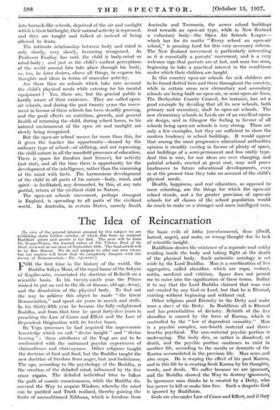Open-Air Schools
/110-DAY we look with horror on an age which accepted the child chimney sweep, ay.d employed children for long hours in factories and mines ; yet in point of time that period is separated from ours by hardly more than half a century. Will our present attitude towards school children cause a like condemnation in our descen- dants of 1977 ?
By the time that the employment of children in factories had- ceased, people had become used to the idea of their being kept in confinement, and thus it was that, in 1870, the School Board Act substituted the educational factory for the industrial factory. With such a beginning it is small wonder that these schools took little or no account of the nature of the child. The State paid the piper and expected results, and cared little how theSe results were obtained. The school buildings themselves seemed to take a manufacturing plant for their model. It is only very recently that the need for the study of the child's nature, and the need for the adaptation of the school to this nature, has been at all widely recognized. Even to-day we are very far from having reached the ideal. Children are still herded in their thousands into barrack-like schools, deprived of the air and sunlight which is their birthright, their natural activity is repressed, and they are taught and talked at instead of being allowed to - learn. - - The intimate relationship between body and mind is only slowly, very slowly, becoming recognized. As Professor Findlay has -said, • the child is body-mind or mind-body ; and just as the child's earliest perceptions of the world around him take place through his body, so, too, he later desires, above all things, to express his thoughts and ideas in terms of muscular activity.
Are there then no schools which take into account the child's physical needs while catering for his mental equipment ? Yes, there are, but the general public is hardly aware of their existence. They are called open- air schools, and during the past twenty years the move- ment in favour of these schools has been steadily growing, and the good effects on nutrition, growth, and general health of returning the child, during school hours, to his natural environment of the open air and sunlight are slowly being recognized.
But the open-air school means far more than this, for it gives the teacher the opportunity—denied by the ordinary type of school—of utilizing, and not repressing, the child nature in all the manifold processes of education. There is space for freedom (not- licence), for activity (not riot), and all the time there is opportunity for the development of the intelligence, rather than the cramming of the mind with facts. The harmonious development of the child in all parts of his nature—body, mind, and spirit—is facilitated, nay demanded, by this, at any rate partial, return of the civilized child to Nature.
The open-air schools movement, perhaps strongest in England, is spreading to all parts of the civilized world. In Australia, in certain States, namely South Australia and Tasmania, the newer school buildings tend towards an open-air type, while in New Zealand a voluntary body—the Open Air Schools League— which has for its motto "-Every school an open-air school," is pressing hard for this very necessary reform. The New Zealand movement is particularly interesting as it is essentially a parents' movement, and is a very welcome sign that parents are at last, and none too soon, beginning to take a practical interest in the conditions under which their children are taught.
In this country open-air schools for sick children are to be found dotted here and there throughout the country, while in certain areas new elementary and secondary schools are being built on open-air, or semi-open-air lines. The Derbyshire County Council, for instance, has set a good example by deciding that all its new schools, both primary and secondary, shall be open-air schools. The new elementary schools in Leeds are of an excellent open- air design, and in Glasgow the feeling in favour of all schools being open-air schools is very strong. These are only a few examples, but they are sufficient to show the modern tendency in school buildings. It would appear that among the most progressive educational authorities opinion is steadily veering in favour of plenty of space, and buildings of a semi-permanent and less costly type. And this is wise, for our ideas are ever changing, and palatial schools, erected at great cost, may well prove hindrances to future educational developments, even as at the present time they take no account of the child's physical needs.
Health, happiness, and real education, as opposed to mere schooling, are the things for which the open-air school stands, and a far greater provision of open-air schools for all classes of the school population would do much to make us a stronger and more intelligent race.



















































 Previous page
Previous page